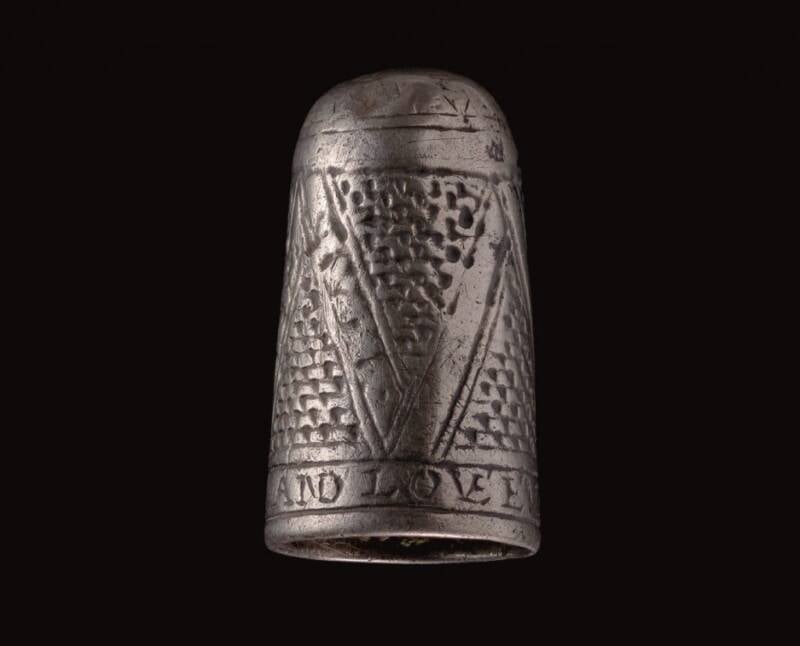The thimble was found by a metal detectorist in Pembrokeshire who initially thought he'd merely dug up a sixpence coin.

National Museum CardiffThe inscribed thimble may have been a gift from one lover to another.
Centuries ago, a silver thimble inscribed with a sweet love note slipped off someone’s finger. Now, it’s been found by a metal detectorist in Wales — and declared an official treasure.
It’s one of several objects, including a silver pendant, several fragmented ax heads, and a silver letter sealer, to earn this distinction recently.
Discovering The Thimble In Wales
The silver thimble was discovered, completely by chance, by a metal detectorist named Robert Edwards. According to a press release from the National Museum Cardiff, Edwards was metal detecting in Carew Community, Pembrokeshire, when he made his find in November 2020.
“I was out detecting under the shade of an oak tree and was having no luck, until I changed the program and found a great crisp signal,” Edwards recalled in the press release. “At first I thought it may be a sixpence, but to my surprise it was something silver — and not a coin!”

welshbabe/Wikimedia CommonsEdwards made his find in Carew Community, Pembrokeshire, seen here. He speculated that the thimble might have come from a castle in the area.
He added: “It wasn’t until later when I saw the similar waffle pattern on another thimble that I knew I had found something special. To be honest, my cousin (who is also my detecting partner) was a little jealous!”
The thimble, which dates to between 1682 and 1740, according to Artnet, is heavy, tall, and narrow. It’s made of a rounded top soldered to the main body, with six traverse bands arranged in a zigzag pattern.
Most remarkably of all, the thimble is inscribed with capital letters that spell out a sweet love note: “LYKE STIL AND LOVE EVER.”
“‘Posy’ inscriptions can be seen on several 17th century silver thimbles from across England and Wales,” the National Museum Cardiff explained in their press release about the find. “Romantic passages such as this are very similar to those seen on contemporary posy rings. Perhaps thimbles, worn on the finger during needlework, were considered an intimate (and therefore romantic) possession, suitable as a gift between lovers.”
The thimble was just declared a treasure by Welsh officials. But it’s not the only treasure that was recognized.
Other Recent Discoveries Declared Treasures
The silver thimble found by Edwards and declared a treasure was just one of several items that were recently recognized as such. The others include a silver pendant, a Bronze Age hoard with copper-alloy fragments — probably from ax heads — and a medieval silver seal matrix used to close letters.
Of these, however, the pendant is perhaps the most remarkable.
Discovered in July 2020 by metal detectorist Nicholas Davies in Llansteffan Community, Carmarthenshire, the double-sided pendant depicts King Charles I on one side and Queen Henrietta Maria on the other. The National Museum Cardiff believes that it dates to the 17th century and that it was given to friends and supporters of Charles I during the English Civil War.

Public DomainKing Charles I was executed in 1649 after the English Civil War.
“I visited the field on a particularly warm and dry July morning, which can often limit the amount of finds that you discover,” Davies said of his remarkable discovery. “However, this time I received a confident reading on the metal detector. As I un-earthed the signal from the hole, I gently revealed a silver oval item with the striking bust of an elegant lady.”
He continued: “Taking in the precious moment, I sat down holding this truly magnificent find whilst trying to imagine the story that it would tell. Who had dropped it? What connections did they have to it? How did they come about this item?”
It’s a question that can be asked of all the above treasures. For his part, Edwards also expressed curiosity about where the silver thimble had come from. He wonders if it originated from a nearby castle.
“I like to think about who used it,” he remarked. “Was it used in the castle I could see over the way? Did someone get in trouble when it was lost? I’m very happy that I’ve been able to share it with the rest of you.”
After reading about the silver thimble inscribed with a love note that a metal detectorist found in Wales, go inside the Cherokee legend of the Moon-Eyed People, which suggests that Welsh explorers landed in North America 300 years before Christopher Columbus. Or, discover the devastating story of Wales’ Aberfan Disaster of 1966.





